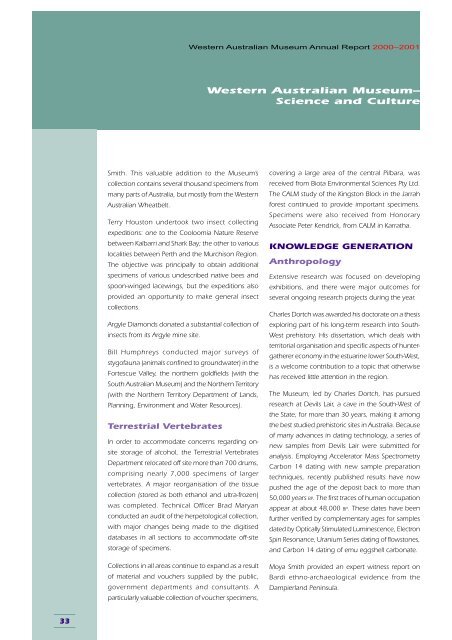Annual Report-2000-2001 - Western Australian Museum - The ...
Annual Report-2000-2001 - Western Australian Museum - The ...
Annual Report-2000-2001 - Western Australian Museum - The ...
Create successful ePaper yourself
Turn your PDF publications into a flip-book with our unique Google optimized e-Paper software.
33<br />
Smith. This valuable addition to the <strong>Museum</strong>’s<br />
collection contains several thousand specimens from<br />
many parts of Australia, but mostly from the <strong>Western</strong><br />
<strong>Australian</strong> Wheatbelt.<br />
Terry Houston undertook two insect collecting<br />
expeditions: one to the Cooloomia Nature Reserve<br />
between Kalbarri and Shark Bay; the other to various<br />
localities between Perth and the Murchison Region.<br />
<strong>The</strong> objective was principally to obtain additional<br />
specimens of various undescribed native bees and<br />
spoon-winged lacewings, but the expeditions also<br />
provided an opportunity to make general insect<br />
collections.<br />
Argyle Diamonds donated a substantial collection of<br />
insects from its Argyle mine site.<br />
Bill Humphreys conducted major surveys of<br />
stygofauna (animals confined to groundwater) in the<br />
Fortescue Valley, the northern goldfields (with the<br />
South <strong>Australian</strong> <strong>Museum</strong>) and the Northern Territory<br />
(with the Northern Territory Department of Lands,<br />
Planning, Environment and Water Resources).<br />
Terrestrial Vertebrates<br />
In order to accommodate concerns regarding onsite<br />
storage of alcohol, the Terrestrial Vertebrates<br />
Department relocated off site more than 700 drums,<br />
comprising nearly 7,000 specimens of larger<br />
vertebrates. A major reorganisation of the tissue<br />
collection (stored as both ethanol and ultra-frozen)<br />
was completed. Technical Officer Brad Maryan<br />
conducted an audit of the herpetological collection,<br />
with major changes being made to the digitised<br />
databases in all sections to accommodate off-site<br />
storage of specimens.<br />
Collections in all areas continue to expand as a result<br />
of material and vouchers supplied by the public,<br />
government departments and consultants. A<br />
particularly valuable collection of voucher specimens,<br />
<strong>Western</strong> <strong>Australian</strong> <strong>Museum</strong> <strong>Annual</strong> <strong>Report</strong> <strong>2000</strong>–<strong>2001</strong><br />
<strong>Western</strong> <strong>Australian</strong> <strong>Museum</strong>–<br />
Science and Culture<br />
covering a large area of the central Pilbara, was<br />
received from Biota Environmental Sciences Pty Ltd.<br />
<strong>The</strong> CALM study of the Kingston Block in the Jarrah<br />
forest continued to provide important specimens.<br />
Specimens were also received from Honorary<br />
Associate Peter Kendrick, from CALM in Karratha.<br />
KNOWLEDGE GENERATION<br />
Anthropology<br />
Extensive research was focused on developing<br />
exhibitions, and there were major outcomes for<br />
several ongoing research projects during the year.<br />
Charles Dortch was awarded his doctorate on a thesis<br />
exploring part of his long-term research into South-<br />
West prehistory. His dissertation, which deals with<br />
territorial organisation and specific aspects of huntergatherer<br />
economy in the estuarine lower South-West,<br />
is a welcome contribution to a topic that otherwise<br />
has received little attention in the region.<br />
<strong>The</strong> <strong>Museum</strong>, led by Charles Dortch, has pursued<br />
research at Devils Lair, a cave in the South-West of<br />
the State, for more than 30 years, making it among<br />
the best studied prehistoric sites in Australia. Because<br />
of many advances in dating technology, a series of<br />
new samples from Devils Lair were submitted for<br />
analysis. Employing Accelerator Mass Spectrometry<br />
Carbon 14 dating with new sample preparation<br />
techniques, recently published results have now<br />
pushed the age of the deposit back to more than<br />
50,000 years BP. <strong>The</strong> first traces of human occupation<br />
appear at about 48,000 BP. <strong>The</strong>se dates have been<br />
further verified by complementary ages for samples<br />
dated by Optically Stimulated Luminescence, Electron<br />
Spin Resonance, Uranium Series dating of flowstones,<br />
and Carbon 14 dating of emu eggshell carbonate.<br />
Moya Smith provided an expert witness report on<br />
Bardi ethno-archaeological evidence from the<br />
Dampierland Peninsula.

















